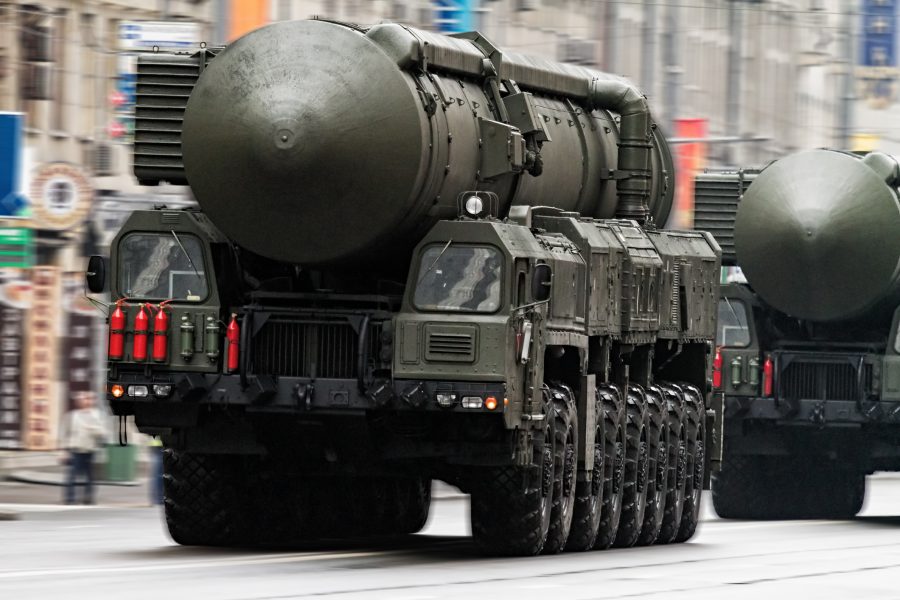
As NATO and Russia edge ever closer to conflict in Ukraine, a popular view is that any direct encounter between them will almost inevitably lead to nuclear war. Certainly, that’s the line that Russian President Vladimir Putin is spinning. In fact, history shows that there may be a lot of space for nuclear-armed adversaries to fight a limited conventional war without using nuclear weapons.
During the Cold War, many policymakers grew accustomed to the view that nuclear-armed adversaries would go to great lengths to avoid direct conventional military provocation for fear of escalation to a nuclear exchange. But at the same time, nuclear strategists believed that nuclear weapons could embolden challengers to take more and more risks underneath the nuclear shadow. In nuclear-war theory, this is called the ‘stability–instability paradox’.
The famous Cold War nuclear strategist Glenn Snyder argued that, while the fear of mutually assured destruction can create stability at a strategic level, nuclear weapons can simultaneously create instability by enabling lower levels of violence. In other words, creating a nuclear ceiling that both sides don’t wish to breach can provide considerable space for conflict beneath that ceiling.
The size of the space for non-nuclear conflict between nuclear powers is dependent on the circumstances and the countries involved. American political scientist Robert Jervis, for example, argued that challengers would be much more likely to engage in nuclear risk-taking, including the use of asymmetrical strategies against status quo powers.
For the Soviet Union and the United States during the Cold War, this instability took the shape of numerous proxy wars between them across the globe, although the two countries were also generally careful to avoid direct conventional conflict between their military forces.
Although the Soviet military was deployed to assist local forces against the US and its allies in the
Korean War (pilots) and Vietnam War (technical advisers), they mostly kept a low profile. Similarly, in the 1980s the US and UK quietly deployed small numbers of special forces to Afghanistan to train mujahideen in the use of anti-aircraft missiles, but (as far as we know) they didn’t engage in direct combat.
Yet the post–Cold War experience is that nuclear-armed adversaries are becoming increasingly willing to undertake large-scale conventional and sub-conventional conflicts directly with each other.
South Asia has long been called ‘
the most dangerous place on earth’ because of the frequent nuclear sabre-rattling between India and Pakistan. But the two countries have also fought several wars and other conflicts in the 25 or so years since they became declared nuclear-weapon states.
This included the 1999 Kargil War which involved the incursion into Indian territory by some 5,000 Pakistani troops and paramilitaries, opposed by 20,000 Indian troops and the air force. At least
700 Pakistani and 500 Indian troops died in fighting before Pakistan withdrew.
Pakistan has also sponsored numerous terrorist attacks against India, including the
2001 attack on the Indian parliament and the bloody
assault on Mumbai in 2008 that left some 175 dead. Pakistan has long been the challenger and nuclear risk-taker in these conflicts. India, the status quo power, had to ‘suck it up’ against these attacks, keeping its conventional responses to a minimum.
In recent years, though, India has been far more willing to conduct kinetic operations against its nuclear adversary. This included the so-called
surgical strike by Indian special forces against terrorist bases in Pakistan following the 2016 Uri terrorist attack and
missile strikes against Pakistani territory following the 2019 Pulwama terrorist attack. In the Pulwama case, despite nuclear rhetoric from both sides, the kinetic actions were followed by a
delicate dance between the two countries to de-escalate.
And it’s not just India and Pakistan. In June 2020, Indian and Chinese troops engaged in a brief but bloody fight, the first major conflict on the Himalayan border since they both became nuclear-weapon states. Then, an attack initiated by Indian troops (without weapons) on a newly built Chinese outpost in Ladakh was met with a forceful and deadly response when an estimated 20 Indian troops were bludgeoned to death with clubs and rocks. The
Chinese side suffered 35 casualties, according to US sources. The Indian army has since been authorised to use weapons against Chinese forces.
What all this means for NATO and Russia in Ukraine isn’t entirely clear. For their part, the US and its NATO allies have so far been careful to keep the Ukraine war as essentially a proxy conflict, supplying defensive weaponry but ruling out using airpower to enforce a no-fly zone over Ukraine.
But pressure for greater intervention will grow as the conflict continues, including the possible wholesale destruction of major Ukrainian cities by Russian forces, the potential release of radiological materials from nuclear power plants, or even the intentional use of chemical weapons by Russian forces. Options for NATO could include deploying military advisers or ‘international brigades’ of volunteers. There may also be calls for the deployment of troops to enforce humanitarian corridors for the evacuation of civilians from the besieged cities.
In the meantime, Putin has been doing what he can to play up the nuclear threat against NATO, just as Pakistan has done against India for some 25 years. NATO, as a coalition of status quo powers (only three of which have nuclear weapons), will be sorely put to the test by Russia, the challenger and nuclear risk-taker.
 Print This Post
Print This Post